Beautiful Bauer ~ A Brief History
One thing relocating to the West Coast gave me was an increased appreciation for the wide array of stunning, California Art pottery.
From Brayton Laguna to Gladding McBean to the lesser known pottery makers, many are of unique and distinctive design.
One of the most famous is Bauer pottery. I had seen a piece here and a piece there, when I lived on the Massachusetts North Shore, but I had no idea of the shapes, colors and storied history of this prestigious maker.
Bauer Pottery Beginnings
In 1878, Andreas Bauer, known as J. Andy or J.A., got his introduction to the pottery business in Louisville, Kentucky at Preston Street Pottery, which was owned by his eldest brother John.
By 1885, J. Andy purchased Paducah Pottery, in Paducah, KY. and began his own pottery endeavours.
Like many American art pottery companys, Paducah Pottery initially produced a variety of utilitarian pieces for wholesale and retail such as crocks, whiskey jugs, and oil jars. The company also produced standard redware pieces for the garden, like flowerpots, saucers, seed pans and hanging baskets.
In 1910, Bauer decided to move his family and business to Los Angeles and the J.A. Bauer Pottery Company opened in Lincoln Heights, just north of downtown LA. They began producing many of the same items that had been made in Paducah, but quickly added items more suited to their new surroundings. A wider variety of nursery and floral items joined the line, as well as western-styled pieces befitting the California bungalow aesthetic, such as the Indian bowl.
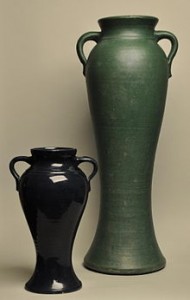
Rebekah Vases from Bauer Pottery Co., circa 1925
During the next decade, business continued to flourish, with floral and gardenwares driving much of the company’s production, along with the important addition of iconic potters Louis Ipsen and Matt Carlton. As the company grew, so too did J.A. Bauer’s personal fortune.
In 1922, J.A. Bauer retired, selling two thirds of the company to investors from the Bernheim family of Louisville and the other third to his daughter Eva and son-in-law Watson Bockman. The next year, J.A. Bauer passed away in his sleep, a little over a month before his 67th birthday.
Though the founder was gone, the namesake J.A. Bauer Pottery Company carried on. Despite its success to that point, the company was yet to create the pottery for which Bauer is most well-known. Seeking change and growth, the Bernheim investors began a transformation of the company with the introduction of a line of dinnerware, created by Ipsen and Carlton. This “yelloware” line stood out, as most tablewares of the time were almost exclusively white.
The decision was made to add more color to the pottery line, which prompted the hiring of ceramic engineer Victor Houser. A set of ringed flower pots in different colors was the first test and met with immediate success. A line of brightly colored dinnerware followed soon after.
Despite the popularity of the colored pottery they produced, the Bernheims were losing business. In 1929, they sold their two thirds of the company to J.A. Bauer’s son-in-law Watson Bockman, who held the remaining third, heralding the most popular era of Bauer pottery. Despite Bockman’s early doubts about Houser and his colored glazes, the California ring line, or “ruffled” as it was referred to at the time, soared in popularity. The ring pattern, created by Ipsen, took over and was applied to anything and

Vintage Bauer Pottery flower pots from the author's collection
everything in Bauer Pottery's production line, from ashtrays to tablewares to vases.
Bauer in the Mid-Century
Bauer’s colors and forms sold well across the west and, in 1938, in an attempt to penetrate east coast markets, Bauer developed a pottery production facility in Atlanta, Georgia.
As the 1930s drew to a close, the colorful era of Bauer pottery began to wane as well. By the early 40s, war loomed and access to crucial materials such as copper, tin, lead, and uranium among others was limited, because they were vital to the war effort. Unfortunately, they were also vital to producing Bauer’s brightly colored pottery line.
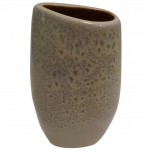
Mid-Century Modern Vase by Russell Wright for Bauer Pottery
It was during this time (1945) that the Bauer company enlisted the aid of famed designer Russell Wright to produce new designs for the company and while beautiful, the effort was short-lived.
Through the 1940s and 50s, changes in American tastes and modern styles, adjustments to the glaze formulas, as well as competition from lines like Russel Wright’s American Modern pushed the evolution of the Bauer product lines. New Bauer product lines like La Linda, Al Fresco and Monterey Moderne owed more to the stylings of Russel Wright and other mid-century modern designers, than to Ipsen’s rings.
Bauer Pottery Falls and Rises Again
Failure to modernize their production processes, as well as battles with the pottery worker’s union, finally led to the demise of the company. With the advent of a strike in October of 1961, little new work was produced and, in early 1962, the Bauer Pottery Co,. ceased operation.
In 1998, current owner Janek Boniecki purchased the trademark rights to reproduce Bauer Pottery designs and a new era of Bauer pottery began. Using existing vintage pieces to derive new molds, the company now manufactures replicas of original Bauer designs, in many original and new colors.
Original Bauer Pottery vs. Reproduction, "New" Bauer
As a collector, it's important to note that there are now authentic reproductions of original, early J.A. Bauer Pottery wares.
Many of the new Bauer pottery's first products carried marks very similar to marks on original Bauer ring ware and, beginning in 2000, the new products began including "2000" in the marks. Keep in mind that all vintage Bauer marks are impressed, or incised, into the clay. Some new Bauer marks are raised. Any raised Bauer mark, with or without 2000, is new. Many, but certainly not all, vintage pieces of Bauer have a model number included with the mark. No new Bauer has an impressed model number.
You can find out more about Bauer mark and vintage wares vs. repro's at RealorRepro.com.
Buy Bauer Now, on Ebay
| Ebay has returned a malformed xml response. This could be due to testing or a bug in the RSS2 Generator. Please check the support forums to see if there are any posts regarding recent RSS2 Generator bugs. No items matching the keyword phrase "bauer vase" were found. This could be due to the keyword phrase used, or could mean your server is unable to communicate with Ebays RSS2 Server. CURL error code = 6. (Could not resolve host: rest.ebay.com) |
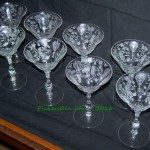
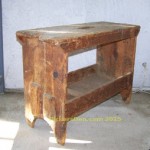
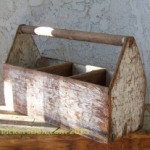
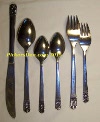

Comments by admin